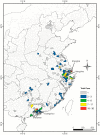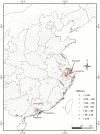Cluster of human infections with avian influenza A (H7N9) cases: a temporal and spatial analysis
- PMID: 25599373
- PMCID: PMC4306894
- DOI: 10.3390/ijerph120100816
Cluster of human infections with avian influenza A (H7N9) cases: a temporal and spatial analysis
Abstract
Objectives: This study aims to describe the spatial and temporal characteristics of human infections with H7N9 virus in China using data from February 2013 to March 2014 from the websites of every province's Population and Family Planning Commission.
Methods: A human infection with H7N9 virus dataset was summarized by county to analyze its spatial clustering, and by date of illness onset to analyze its space-time clustering using the ESRI® Geographic Information System (GIS) software ArcMap™ 10.1 and SatScan.
Results: Based on active surveillance data, the distribution map of H7N9 cases shows that compared to the rest of China, the areas from near the Yangtze River delta (YRD) to farther south around the Pearl River delta (PRD) had the highest densities of H7N9 cases. The case data shows a strong space-time clustering in the areas on and near the YRD from 26 March to 18 April 2013 and a weak space-time clustering only in the areas on and near the PRD between 3 and 4 February 2014. However, for the rest of the study period, H7N9 cases were spatial-temporally randomly distributed.
Conclusions: Our results suggested that the spatial-temporal clustering of H7N9 in China between 2013 and 2014 is fundamentally different.
Figures





References
-
- WHO Avian Influenza A(H7N9) Rivus. 2013. [(accessed on 1 June 2014)]. Available online: www.who.int/influenza/human_animal_interface/influenza_h7n9/10u_ReportWe....
-
- Liu D., Shi W., Shi Y., Wang D., Xiao H., Li W., Bi Y., Wu Y., Li X., Yan J., et al. Origin and diversity of novel avian influenza A H7N9 viruses causing human infection: Phylogenetic, structural, and coalescent analyses. Lancet. 2013;381:1926–1932. doi: 10.1016/S0140-6736(13)60938-1. - DOI - PubMed
-
- WHO Background and Summary of Human Infection with Influenza A(H7N9) Virus—As of 5 April 2013. [(accessed on 1 June 2014)]. Available online: http://www.who.int/influenza/human_animal_interface/update_20130405/en/
Publication types
MeSH terms
LinkOut - more resources
Full Text Sources
Other Literature Sources
Medical
Miscellaneous

